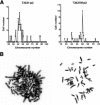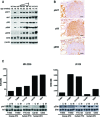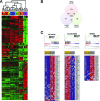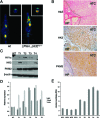Thyrocyte-specific inactivation of p53 and Pten results in anaplastic thyroid carcinomas faithfully recapitulating human tumors
- PMID: 22190384
- PMCID: PMC3282070
- DOI: 10.18632/oncotarget.380
Thyrocyte-specific inactivation of p53 and Pten results in anaplastic thyroid carcinomas faithfully recapitulating human tumors
Abstract
Anaplastic thyroid carcinoma (ATC) is the most aggressive form of thyroid cancer, and often derives from pre-existing well-differentiated tumors. Despite a relatively low prevalence, it accounts for a disproportionate number of thyroid cancer-related deaths, due to its resistance to any therapeutic approach. Here we describe the first mouse model of ATC, obtained by combining in the mouse thyroid follicular cells two molecular hallmarks of human ATC: activation of PI3K (via Pten deletion) and inactivation of p53. By 9 months of age, over 75% of the compound mutant mice develop aggressive, undifferentiated thyroid tumors that evolve from pre-existing follicular hyperplasia and carcinoma. These tumors display all the features of their human counterpart, including pleomorphism, epithelial-mesenchymal transition, aneuploidy, local invasion, and distant metastases. Expression profiling of the murine ATCs reveals a significant overlap with genes found deregulated in human ATC, including genes involved in mitosis control. Furthermore, similar to the human tumors, [Pten, p53]thyr-/- tumors and cells are highly glycolytic and remarkably sensitive to glycolysis inhibitors, which synergize with standard chemotherapy. Taken together, our results show that combined PI3K activation and p53 loss faithfully reproduce the development of thyroid anaplastic carcinomas, and provide a compelling rationale for targeting glycolysis to increase chemotherapy response in ATC patients.
Figures









Similar articles
-
The next generation of orthotopic thyroid cancer models: immunocompetent orthotopic mouse models of BRAF V600E-positive papillary and anaplastic thyroid carcinoma.Thyroid. 2014 Apr;24(4):705-14. doi: 10.1089/thy.2013.0483. Epub 2014 Jan 24. Thyroid. 2014. PMID: 24295207 Free PMC article.
-
The PLK1 inhibitor GSK461364A is effective in poorly differentiated and anaplastic thyroid carcinoma cells, independent of the nature of their driver mutations.Thyroid. 2013 Oct;23(10):1284-93. doi: 10.1089/thy.2013.0037. Epub 2013 Jul 25. Thyroid. 2013. PMID: 23509868 Free PMC article.
-
p53 constrains progression to anaplastic thyroid carcinoma in a Braf-mutant mouse model of papillary thyroid cancer.Proc Natl Acad Sci U S A. 2014 Apr 22;111(16):E1600-9. doi: 10.1073/pnas.1404357111. Epub 2014 Apr 7. Proc Natl Acad Sci U S A. 2014. PMID: 24711431 Free PMC article.
-
Modeling anaplastic thyroid carcinoma in the mouse.Horm Cancer. 2015 Feb;6(1):37-44. doi: 10.1007/s12672-014-0208-8. Epub 2014 Nov 25. Horm Cancer. 2015. PMID: 25420535 Free PMC article. Review.
-
Evidence that one subset of anaplastic thyroid carcinomas are derived from papillary carcinomas due to BRAF and p53 mutations.Cancer. 2005 Jun 1;103(11):2261-8. doi: 10.1002/cncr.21073. Cancer. 2005. PMID: 15880523 Review.
Cited by
-
The next generation of orthotopic thyroid cancer models: immunocompetent orthotopic mouse models of BRAF V600E-positive papillary and anaplastic thyroid carcinoma.Thyroid. 2014 Apr;24(4):705-14. doi: 10.1089/thy.2013.0483. Epub 2014 Jan 24. Thyroid. 2014. PMID: 24295207 Free PMC article.
-
Blocks to thyroid cancer cell apoptosis can be overcome by inhibition of the MAPK and PI3K/AKT pathways.Cell Death Dis. 2014 Mar 6;5(3):e1104. doi: 10.1038/cddis.2014.78. Cell Death Dis. 2014. PMID: 24603332 Free PMC article.
-
Activating BRAF and PIK3CA mutations cooperate to promote anaplastic thyroid carcinogenesis.Mol Cancer Res. 2014 Jul;12(7):979-86. doi: 10.1158/1541-7786.MCR-14-0158-T. Epub 2014 Apr 25. Mol Cancer Res. 2014. PMID: 24770869 Free PMC article.
-
Obatoclax overcomes resistance to cell death in aggressive thyroid carcinomas by countering Bcl2a1 and Mcl1 overexpression.Endocr Relat Cancer. 2014 Oct;21(5):755-67. doi: 10.1530/ERC-14-0268. Epub 2014 Jul 10. Endocr Relat Cancer. 2014. PMID: 25012986 Free PMC article.
-
Anaplastic thyroid cancer cells upregulate mitochondrial one-carbon metabolism to meet purine demand, eliciting a critical targetable vulnerability.Cancer Lett. 2023 Aug 1;568:216304. doi: 10.1016/j.canlet.2023.216304. Epub 2023 Jul 6. Cancer Lett. 2023. PMID: 37422127 Free PMC article.
References
-
- Burns WR, Zeiger MA. Differentiated thyroid cancer. Semin Oncol. 2010;37:557–566. - PubMed
-
- Wang HM, Huang YW, Huang JS, Wang CH, Kok VC, Hung CM, Chen HM, Tzen CY. Anaplastic carcinoma of the thyroid arising more often from follicular carcinoma than papillary carcinoma. Ann Surg Oncol. 2007;14:3011–3018. - PubMed
-
- Quiros RM, Ding HG, Gattuso P, Prinz RA, Xu X. Evidence that one subset of anaplastic thyroid carcinomas are derived from papillary carcinomas due to BRAF and p53 mutations. Cancer. 2005;103:2261–2268. - PubMed
-
- Cornett WR, Sharma AK, Day TA, Richardson MS, Hoda RS, van Heerden JA, Fernandes JK. Anaplastic thyroid carcinoma: an overview. Curr Oncol Rep. 2007;9:152–158. - PubMed
Publication types
MeSH terms
Substances
Grants and funding
LinkOut - more resources
Full Text Sources
Other Literature Sources
Medical
Molecular Biology Databases
Research Materials
Miscellaneous

